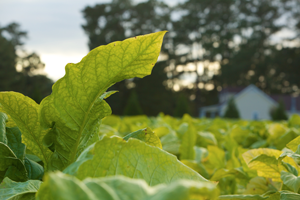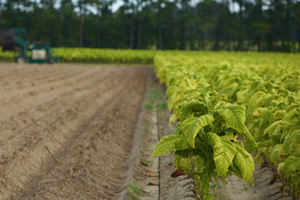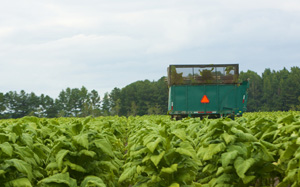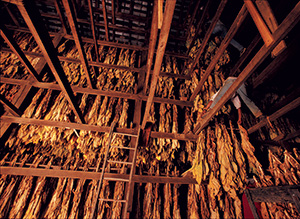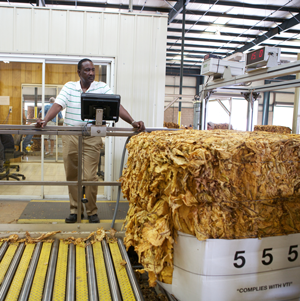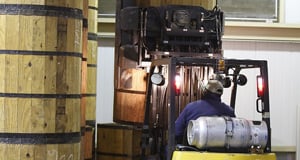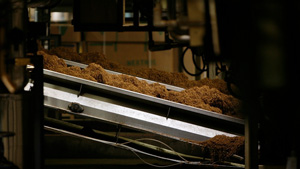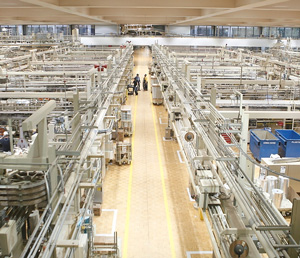Making our Cigarettes
Our Approach to Manufacturing
Manufacturing premium tobacco products begins with high-quality tobacco.
The combination of advanced manufacturing technology; well-trained, engaged and experienced employees; and a system of continuous day-to-day improvement positions PM USA to best maximize our production capacity and manufacture high-quality products at the best possible cost.
Varieties of Tobacco
The primary component in each of our cigarette brands is tobacco. Therefore, quality control of the types and grades we use is critical. American cigarettes are a blend of three main tobaccos: bright, burley and oriental.
Most bright and burley that we use is grown in the United States, while oriental tobacco, also known as Turkish, is grown in several Mediterranean countries.
Bright, which is often called flue-cured or Virginia tobacco, is similar to the large-leaf Spanish tobacco planted by John Rolfe, the English settler credited with the first successful cultivation of tobacco as a cash crop in Virginia. It is grown primarily in Virginia, the Carolinas, Georgia, Alabama and Florida. Burley tobacco is grown primarily in Kentucky and Tennessee, and also in North Carolina, Virginia, West Virginia, Ohio, Indiana and Missouri.
Bright vs. Burley
BRIGHT
Bright tobacco matures from the bottom leaves up, so they are picked first; then each succeeding layer as they mature, until only the top leaves are left for final harvest. Leaves are graded according to their position on the stalk.
BURLEY
The process of growing and selling burley tobacco is similar to that of bright, but there are significant differences in the way burley is harvested and cured.
Harvesting
BRIGHT
Most tobacco farmers today utilize mechanical harvesters. As the bottom leaves of bright tobacco are picked or primed, they are placed on a mechanical harvester. As the harvesters move over a row of tobacco plants, the mature leaves are pulled off the stalk and transported up to removable trailers at the top of the harvester.
BURLEY
When harvesting burley, the entire stalk is cut by hand and air-cured in natural atmospheric conditions over an eight-week period.
Curing
BRIGHT
The first step in preparing harvested bright tobacco for market is curing. The crop is placed in specially equipped structures known as bulk barns. Forced-air heat flows through the leaves of bright tobacco, during a five- to seven-day drying process. This draws out the bright lemon or golden color that gives bright tobacco its name.
BURLEY
Because the entire stalk is cut and hung to cure, instead of leaf by leaf like bright, the stalks are hand-stripped after curing. Burley is reddish-brown in color after curing, much darker than bright tobacco. The leaves are then graded by their position on the stalk. The stalk is discarded and the burley leaves are put into 80- to 90-pound bales for shipment to market.
Purchasing
After curing, bright tobacco will be sold to various domestic and foreign manufacturers in one of two ways: through marketing agreements between farmers and manufacturers or at auction.
Marketing Agreements
Today, many tobacco farmers have marketing agreements with manufacturers under which all or part of their tobacco crop is sold directly to the manufacturers. PM USA purchases nearly all of its domestic tobacco directly from farmers through its Tobacco Leaders Program.
In this program, a farmer brings his or her crop to a receiving station. It is unloaded, visually inspected, moisture tested with electronic equipment and then graded. The farmer often stands beside the grader and observes the evaluation of each bale of tobacco.
This is an opportunity for face-to-face communication between the seller and the buyer. Soon thereafter, the tobacco grower receives payment for his or her crop.
Initial Processing & Aging
After purchase, leaf tobacco must be processed at the stemmery, where moisture is added to make the tobacco pliable enough to remove its large stems. Once the stems are removed, the tobacco is compressed into boxes or porous wooden vats called "hogsheads". These will be stored in special warehouses for approximately two years, while the tobacco undergoes a natural aging and mellowing process.
Primary Processing
Upon completion of the aging process, these same hogsheads and boxes are delivered to primary processing facilities in preparation for cigarette manufacturing. In these facilities, the tobacco undergoes a conditioning process where high temperatures and humidity restore moisture to suitable levels for cutting and blending tobacco and completing the cigarette making process.
Bright, burley and oriental tobaccos are precisely cut and blended according to time-honored formulas, or recipes, to produce tobaccos for various brands of cigarettes. These brand recipes include ingredients and flavors that are added to the tobacco to give each brand its unique characteristics.
Cigarette Making & Packing
The blended tobacco — often referred to as "filler" or "cutfiller" — leaves Primary Processing and is delivered by a pneumatic feed system to cigarette making machines (called makers) within the factory.
At the maker, the tobacco is stored temporarily in hoppers, which continuously allow measured amounts of filler to drop down onto prepared cigarette paper. The paper is wrapped around the tobacco and sealed to form continuous rods. These are then cut to proper length for cigarettes. Filter-tipped brands have a double-length filter inserted between every two cigarettes. Filters are sealed to the rods and then cut in half to produce two cigarettes, each one having a filter on one end.
Packer machines insert cigarettes into packs, packs into cartons and cartons into cases. The cases are then conveyed to the Finished Goods department for temporary storage. From there they are shipped to warehouses to be sold to wholesale distributors. Retailers buy from these wholesale distribution channels.


